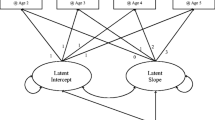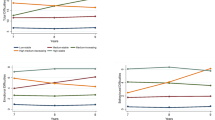Abstract
Latent class analyses were used to analyze data from a sample of children participating in the national evaluation of the Comprehensive Communities Mental Health Services for Children and Their Families Program (N = 6786). Lifetime risk experiences of the child were analyzed to identify 4 classes of boys and girls with similar risk patterns. While low-risk, status-offense, abuse, and high-risk classes were identified for both boys and girls, there were nearly half the number of girls in the low-risk class, almost as many in the status-offense class, twice as many in the abuse class, and more than 3 three times as many in the high-risk class as there were boys. These findings suggest that there are specific groups of children entering services who differ as a function of their lifetime risk exposure. In addition, the relationship between class membership and child functioning, and class membership and family lifetime risk experiences. Understanding these differences provides critical information to the service planning process. In addition, it may result in immediate improvement in the triage of children into services and a better understanding of their behaviors during and after treatment.
Similar content being viewed by others
References
Prior P.Gender and Mental Health. New York: New York University Press; 1999.
Garland A, Zigler E. Psychological correlates of help-seeking attitudes among children and adolescents.American Journal of Orthopsychiatry. 1994;64(4):586–593.
Cuffe S, Waller J, Addy C, et al. A longitudinal study of adolescent mental health service use.Journal of Behavioral Health Services & Research. 2001;28(1):1–11.
Briggs-Gowan M, Horwitz S, Schwab-Stone M, et al. Mental health in pediatric settings: distribution of disorders and factors related to service use.Journal of the American Academy of Child & Adolescent Psychiatry. 2000;39(7):841–849.
Griffin J, Cicchetti D, Leaf P. Characteristics of youths identified from a psychiatric case register as first-time users of services.Hospital and Community Psychiatry. 1999;44(1):62–65.
LaClave L, Campbell J. Psychiatric intervention in children: sex differences in referral rates.Journal of the American Academy of Child & Adolescent Psychiatry. 1986;25(3):430–432.
Burns B, Costello E, Angold A, et al. Children's mental health service use across service sectors.Health Affairs. 1995;14(3):147–159.
Liao Q, Manteuffel B, Paulic C, et al. Describing the population of adolescents served in systems of care.Journal of Emotional and Behavioral Disorders. 2001;9(1):13–29.
Reid R, Riccio CA, Kessler RH, et al. Gender and ethnic differences in ADHD as assessed by behavior ratings.Journal of Emotional and Behavioral Disorders. 2000;8(1):38–48.
Kann R, Hanna F. Disruptive behavior disorders in children and adolescents: how do girls differ from boys.Journal of Counseling & Development. 2000;78(3):267–274.
Compas B, Oppedisano G, Conner J, et al. Gender differences in depressive symptoms in adolescence: comparison of national samples on clinically referred and nonreferred youth.Journal of Consulting and Clinical Psychology. 1997;65(4):617–626.
Barton G, Rey J, Simpson P, Denshire E. Patterns of critical incidents and their effect on outcome in an adolescent inpatient service.Australian and New Zealand Journal of Psychiatry. 2001;43(2):155–159.
Harrison P, Hoffman N, Edwall G. Sexual abuse correlates: similarities between male and female adolescents in chemical dependency treatment.Journal of Adolescent Research. 1989;4:385–399.
Toray T, Coughlin C, Vuchinich S, et al. Gender differences associated with adolescent substance abuse: comparisons and implications for treatment.Journal of Applied Family & Child Studies. 1991;40(3):338–344.
Ellis R, O'Hara M, Sowers K. Profile-based intervention: developing gender-sensitive treatment for adolescent substance abusers.Research on Social Work Practice. 2000;10(3):327–347.
Zito J, Safer D, dosReis S, et al. Psychotherapeutic medication patterns for youths with attention-deficit/hyperactivity disorder.Archives of Pediatrics & Adolescent Medicine. 1999;153(12):1257–1263.
Zito J, Safer D, dosReis S, et al. Trends in the prescribing of psychotropic medications to preschoolers.Journal of the American Medical Association. 2000;283(8):1025–1030.
Pavkov T, George R, Czapkowicz J. Predictors of length of stay among youths hospitalized in state hospitals in Illinois.Journal of Child and Family Studies. 1997;6(2):221–231.
Cuffe S, Waller J, Cuccaro M, et al. Race and gender differences in the treatment of psychiatric disorders in young adolescents.Journal of the American Academy of Child & Adolescent Psychiatry. 1996;34(11):1536–1543.
Everitt B. Unresolved problems in cluster analysis.Biometrics. 1979;35(1):169–181.
Byron J, Morgan A, Ray P. Non-uniqueness and inversions in cluster analysis.Applied Statistics. 1995;44(1):117–134.
McLachlan G, Peel D.Finite Mixture Models. New York: Wiley; 2000.
McCutcheon A.Latent Class Analysis. Beverly Hills, Calif: Sage; 1987.
Muthvn B, Muthvn L.Mplus User's Guide. Los Angeles: Muthvn & Muthvn; 1998.
Muthvn B, Muthvn L. Integrating person-centered and variable-centered analyses: growth mixture modeling with latent trajectory classes.Alcoholism: Clinical and Experimental Research. 2000;24:1–10.
Center for Mental Health Services.Annual report to Congress on the evaluation of the Comprehensive Community Mental Health Services for Children and Their Families Program, 2002. Atlanta, Ga: ORC Macro.
Stephens RL, Liao Q. Service delivery approach, service utilization patterns, and their influence on children's outcomes. In: Newman C, Liberton CJ, Kutash K, Friedman R, eds.The 15th Annual Research Conference Proceedings, A System of Care for Children's Mental Health: Expanding the Research Base. Tampa, Fla: University of South Florida, The Louis de la Parte Florida Mental Health Institute, Research and Training Center for Children's Mental Health. In press.
CMHS.Annual Report to Congress on the Evaluation of the Comprehensive Community Mental Health Services for Children and Their Families Program. Atlanta, Ga: Macro International Inc; 1997.
CMHS.Annual Report to Congress on the Evaluation of the Comprehensive Community Mental Health Services for Children and Their Families Program. Atlanta, Ga: ORC Macro; 1998.
CMHS.Annual Report to Congress on the Evaluation of the Comprehensive Community Mental Health Services for Children and Their Families Program. Atlanta, Ga: ORC Macro; 1999.
Holden E, Friedman R, Santiago R. Overview of the national evaluation of the Comprehensive Community Mental Health Services for Children and Their Families Program.Journal of Emotional and Behavioral Disorders. 2001;9(1):4–12.
Walrath C, Mandell D, Liao Q, et al. Suicide attempts in the Comprehensive Community Mental Health Services for Children and Their Families Program.Journal of the American Academy of Child & Adolescent Psychiatry. 2001;40(10):1197–1205.
Walrath C, Sharp M, Zuber M, et al. Serving children with serious emotional disturbance in urban systems of care: referral agency differences in child characteristics in Baltimore and the Bronx.Journal of Emotional and Behavioral Disorders. 2001;9(2):94–105.
Manteuffel B, Stephens R, Santiago R. Overview of the national evaluation of the Comprehensive Community Mental Health Services for Children and Their Families Program.Children's Services: Social Policy, Research, and Practice. 2002;5(1):3–20.
Hodges K.Child and Adolescent Functional Assessment Scale. Ypsilanti, Mich: Department of Psychology, Eastern Michigan University; 1994.
Hodges K, Wong M. Psychometric characteristics of a multidimensional measure to assess impairment: the Child and Adolescent Functional Assessment Scale.Journal of Child and Family Studies. 1996;5(4):445–467.
Hodges K, Wong M. Use of the Child and Adolescent Functional Assessment Scale (CAFAS) to predict service utilization and cost.Journal of Mental Health Administration. 1997;24(3):278–290.
Hodges K, Doucette-Gates A, Kim C. Predicting service utilization with the Child and Adolescent Functional Assessment Scale in a sample of youth with serious emotional disturbance served by Center for Mental Health Service-funded demonstrations.Journal of Behavioral Health Services & Research. 2000;27(1):47–59.
Hodges K.CAFAS Manual for Training Coordinators, Clinical Administrators and Data Managers. Ypsilanti, Mich: Eastern Michigan University; 1997.
Schwartz G. Estimating the dimensions of a model.The Annals of Statistics. 1978;6:461–464.
Sclove LS. Application of model-selection criteria to some problems in multivariate analysis.Psychometrika. 1987;52:333–343.
Lo Y, Mendell NR, Rubin DB. Testing the number of components in a normal mixture.Biometrika. 2001;88:767–778.
Ramaswamy V, DeSarbo W, Reibstein D, et al. An empirical pooling approach for estimating marketing mix elasticities with PIMS data.Marketing Science. 1993;12:103–124.
Arbuckle JL. Full information estimation in the presence of incomplete data. In: Marcoulides GA, Schumacker RE, eds.Advances in Structural Equation Modeling: Issues and Techniques. Mahwah, NJ: Erlbaum; 1996.
Little RJ. Modeling the dropout mechanism in repeated-measure studies.Journal of the American Statistical Association. 1995;90:1112–1121.
Muthvn B, Shedden K. Finite mixture modeling with mixture outcomes using the E< algorithm.Biometrics. 1999;6:463–469.
Schafer JL, Graham JW. Missing data: our view of the state of the art.Psychological Methods. 2002;7:147–177.
Clark DB, Winters KC. Measuring risks and outcomes in substance use disorders prevention research.Journal of Consulting and Clinical Psychology. 2002;70(6):1207–1223.
Stroul BA, Friedman RM.A System of Care for Children and Youth With Severe Emotional Disturbances. Rev ed. Washington, DC: Georgetown University Child Development Center, CASSP Technical Assistance Center; 1986.
Pires SA.Building Systems of Care: A Primer. Washington, DC: National Technical Assistance Center for Children's Mental Health, Georgetown University Child Development Center; 2002.
Farmer EMZ. Issues confronting effective services in systems of care.Children and Youth Services Review. 2000;22:627–650.
Kopta SM, Howard KI, Lowery JL, et al. Patterns of symptomatic recovery in psychotherapy.Journal of Consulting and Clinical Psychology. 1994;62:1009–1016.
Bates M. The Child and Adolescent Functional Assessment Scale (CAFAS): review and current status.Clinical Child and Family Psychology Review. 2001;4:63–84.
Cicchetti D, Richters JE. Developmental considerations in the investigation of conduct disorder.Development and Psychopathology. 1993;5:331–344.
Brook JS, Balka EB, Brook DW, et al. Drug use among African Americans: ethnic identity as a protective factor.Psychological Reports. 1998;83:1427–1446.
Rae-Grant N, Thomas BH, Offord DR, et al. Risk, protective factors, and the prevalence of behavioral and emotional disorders in children and adolescents.Journal of the American Academy of Child & Adolescent Psychiatry. 1989;28(2):262–268.
Resnick MD, Bearman PS, Blum RW, et al. Protecting adolescents from harm: findings from the National Longitudinal Study of Adolescent Health.Journal of the American Medical Association. 1997;278(10):823–832.
Author information
Authors and Affiliations
Corresponding author
Rights and permissions
About this article
Cite this article
Walrath, C., Petras, H., Mandell, D.S. et al. Gender differences in patterns of risk factors among children receiving mental health services: Latent class analyses. The Journal of Behavioral Health Services & Research 31, 297–311 (2004). https://doi.org/10.1007/BF02287292
Issue Date:
DOI: https://doi.org/10.1007/BF02287292




